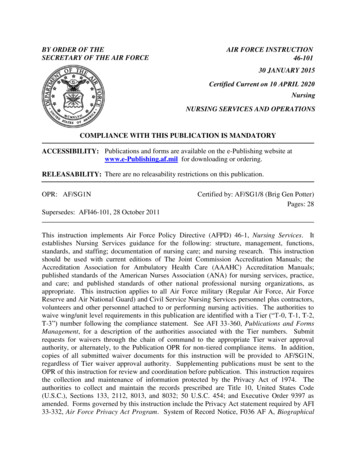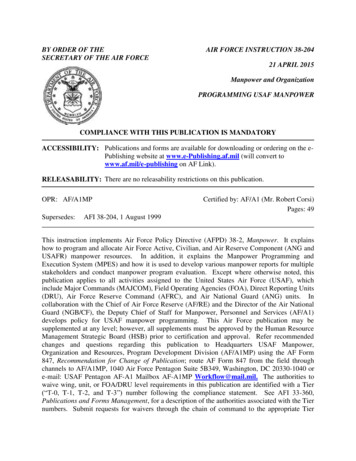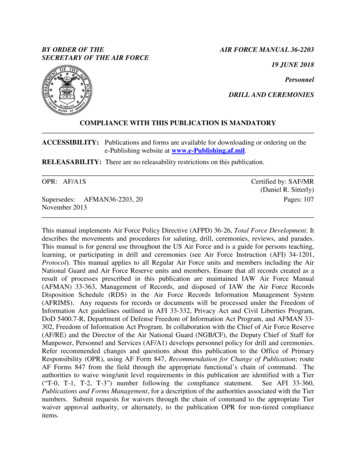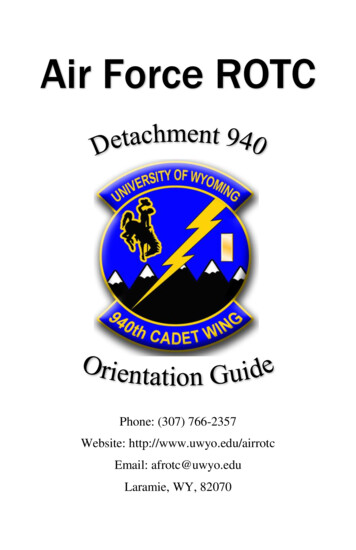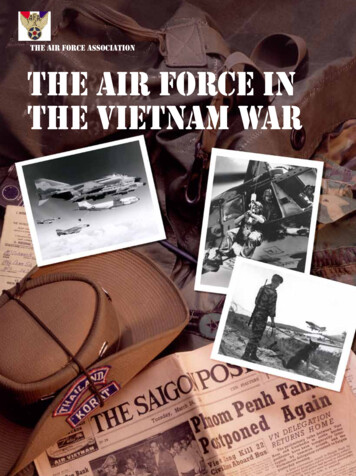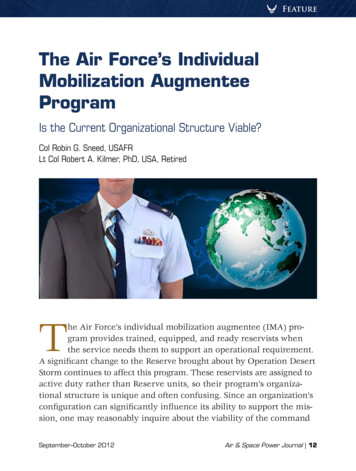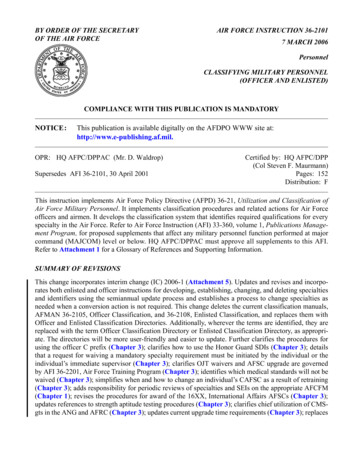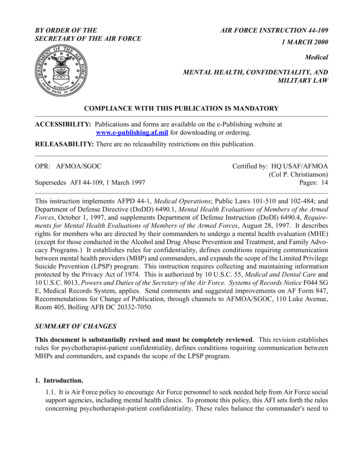
Transcription
DEPARTMENT OF THE AIR FORCEHeadquarters, U.S. Air ForceWashington, DC 20330-1030CFETP 3N0XXParts I and II1 June 2020Air Force Specialty Code (AFSC) 3N0XXPublic Affairs SpecialtiesCAREER FIELD EDUCATIONAND TRAINING PLAN (CFETP)ACCESSIBILITY: Publications and forms are available on the e-publishing website at www.epublishing.af.mil for downloading or ordering.RELEASABILITY: There are no releasability restrictions on this publication.
Public Affairs Badge Heraldry“The quill represents the free flow of information about the Air Force, and the lightning boltsymbolizes the speed of communication. The globe denotes our worldwide audience.”IAW AFI 36-2101, Classifying Military Personnel, the Public Affairs badge is awarded asfollows:Wear the basic badge after completing technical school. Wear the senior badge after award of the7-skill level and the master badge as a master sergeant or above with 5 years in the specialty fromaward of the 7-skill level.2
CFETPPUBLIC AFFAIRS SPECIALTIESAFSC 3N0XXTable of ContentsPart IPrefaceAbbreviations/Terms ExplainedSection A, General InformationPurpose of the CFETPUse of the CFETPCoordination and Approval of the CFETPSection B, Career Progression and InformationSpecialty DescriptionsSkill/Career ProgressionApprentice Level (3)Journeyman Level (5)Craftsman Level (7)Superintendent Level (9)Training DecisionsCareer PathSection C, Skill Level Training RequirementsPurposeSpecialty QualificationsApprentice Level (3)Journeyman Level (5)Craftsman Level (7)Superintendent Level (9)Section D, Transition Training GuidePart IISection A, Specialty Training Standards (STS)3N0X6, Common CoreProficiency CodesPublic Affairs StandardsWing StandardsAFN StandardsProduction StandardsCombat Camera StandardsSection B, Course Objective ListSection C, Support MaterialsSection D, Training Course IndexSection E, MAJCOM Unique Requirements------------------------------------- 4------------------------------------- 5------------------------------------- 11------------------------------------- 11------------------------------------- 11------------------------------------- 12------------------------------------- 17------------------------------------- 17------------------------------------- 17------------------------------------- 17------------------------------------- 17------------------------------------- 17------------------------------------- 18------------------------------------- 19------------------------------------- 19------------------------------------- 19------------------------------------- 19------------------------------------- 20------------------------------------- 21------------------------------------- 21------------------------------------- 22------------------------------------- 24------------------------------------- 25------------------------------------- 38------------------------------------- 43------------------------------------- 46------------------------------------- 48------------------------------------- 59------------------------------------- 59------------------------------------- 59------------------------------------- 59OPR: SAF/PACertified By: CMSgt Raheem Moore, AF Career Field Manager – 3N0 (SAF/PA)Supersedes: 3N0XX, 1 November 2014Pages: 593
PUBLIC AFFAIRS SPECIALTIESAFSC 3N0XX CFETPPart IPreface1. The CFETP is a comprehensive education and training document that identifies life-cycleeducation/training requirements, training support resources, and minimum core task requirementsfor this specialty. The CFETP will provide Public Affairs (PA) personnel a clear career path tosuccess and will instill rigor in all aspects of career field training. Note: Civilians occupyingassociated positions may use Part II to support duty position qualification training. Air ForceReserve Command (AFRC) and Air National Guard (ANG) career paths will differ from the careerpaths depicted in this document. They may develop career paths that more accurately describe thelife- cycle of reserve and guard personnel.2. The CFETP consists of two parts; both parts of the plan are used by supervisors to plan, manage,and control training within the career field.2.1. Part I provides information necessary for overall management of the specialty. Section Aexplains how everyone will use the plan; Section B identifies career field progression information,duties and responsibilities, training strategies, and career field path; Section C associates each levelwith specialty qualifications (knowledge, education, training, and other); Section D indicatesresource constraints (some examples are funds, manpower, equipment, and facilities); Section Eidentifies transition training guide requirements for SSgt through MSgt.2.2. Part II includes the following: Section A identifies the Specialty Training Standards (STS)and includes duties, tasks, technical references to support training, Air Education and TrainingCommand (AETC) conducted training, wartime course, core task, and correspondence courserequirements; Section B identifies the course objective list; Section C identifies available supportmaterials (an example is a Qualification Training Package (QTP) which may be developed tosupport proficiency training and they are identified in http://www.e-publishing.af.mil); Section Didentifies a training course index supervisors can use to determine resources available to supporttraining (included here are both mandatory and optional courses); Section E identifies a majorcommand’s (MAJCOM) unique training requirements supervisors can use to determine additionaltraining required for the associated qualification needs.3. Using guidance provided in the CFETP will ensure individuals in PA specialties receiveeffective and efficient training at the appropriate point in their career. This plan will enable us totrain today's work force for tomorrow's jobs. At unit-level, supervisors and trainers will use Part IIto identify, plan and conduct training commensurate with the overall goals of this plan.4
Abbreviations/Terms Explained3N0 Designations. 3N0XX includes PA specialties, 3N0X6 and 3N090 AFSC; does not include3N000. 3N03X, 3N05X, and 3N07X refer to the skill level progression for the respective specialty(i.e. 3N03X 3N036).Advanced Distributed Learning Service (ADLS). A worldwide-accessible, web-based LearningManagement System (LMS) that provides delivery, tracking, and on-demand reporting oftraining with no client software required to access the system. ADLS is located athttps://golearn.adls.af.mil/login.aspx.Advanced Training (AT). A formal course that provides individuals who are qualified in one ormore positions of their Air Force Specialty (AFS) with additional skills and knowledge to enhancetheir expertise in the career field. Designed for selected career Airmen at the advanced level of theAFS.AEF Reporting Tool (ART). The Air Expeditionary Force (AEF) reporting tool on SIPRNETthat provides timely and accurate readiness.AETC Training Manager (AETC-TM). AETC-TM acts as a link between the customer,MAJCOMs and the training providers (schoolhouse). Collectively, we refer to the trainingsquadrons, courses, instructors, and curriculum developers, as the schoolhouse. The AETC-TMmoderates the long-term, visionary training goals of the career field with the real-time ability ofthe schoolhouse to meet those training goals.AETC Training Pipeline Manager (AETC-TPM). Responsible for the oversight, developmentand execution of all formal training to include money, manpower, and machines to bring newtraining on-line. Co-chairs with the Air Force Career Field Manager (AFCFM), Utilization andTraining Workshops (U&TWs), and AFS planning meetings. Acts as liaison between AFCFM andtraining community.Air Force Career Field Manager (AFCFM). An individual who is the single point of contact(POC) responsible for overall management of an AFS. The AFCFM’s responsibilities includepolicy development, training, skills management, and career progression.Air Force Enlisted Classification Directory (AFECD). Establishes the occupational structure ofthe Air Force enlisted force. The occupational structure is flexible to permit enlisted personnel tospecialize and develop their skills and abilities while allowing the Air Force to meet changingmission requirements. It is located at https://mypers.af.mil/app/answers/detail/a id/7504.Air Force Specialty (AFS). A group of positions (with the same title and code) that requirecommon qualifications.5
Air Force Job Qualification Standard/Command Job Qualification Standard(AFJQS/CJQS). A comprehensive task list common to all persons serving in the duty position,which describe a particular job type or duty position. They are used by supervisors to documenttask qualifications. The tasks on AFJQS/CJQS are common to all persons serving in the describedduty position.Allocation Curves. The relation of hours of training in different training settings to the degree ofproficiency which can be achieved on specified performance requirements.Automated Information Multimedia Management (AIM2). An online system designed forusers to input and query data regarding current unit information, equipment requirements andinventory status, and production reporting information for each DVIAN-authorized VisualInformation (VI) activity. AIM2 assists Air Force Public Affairs Agency (AFPAA) and MAJCOMleaders with decision-making analysis for the VI Equipment Plan (VIEP) and production reportingthroughout the Air Force PA community.Bridge Course. A formal or informal course of training which allows an Airman to expand theirknowledge in another area of expertise.Career Field Education and Training Plan (CFETP). A comprehensive core training documentthat identifies life-cycle education and training requirements, training support resources, and theminimum core task requirements for a specialty.Career Training Guide (CTG). A document that uses task modules (TMs) in lieu of tasks todefine performance and training requirements for a career field.Certification. A formal indication of an individual’s ability to perform a task to requiredstandards.Certification Official. A person whom the supervisor assigns to determine an individual’s abilityto perform a task to required standards.Continuation Training. Additional training exceeding requirements with emphasis on present orfuture duty assignments.Core Task. Tasks the AFCFM identifies as minimum qualification requirements within an AFSC,regardless of duty position. Core tasks may be specified for a particular skill level or in generalacross the AFSC. Guidance for using core tasks can be found in the applicable CFETP narrative.Course Objective List (COL). A publication, derived from initial and advanced skills coursetraining standards, identifying the tasks and knowledge requirements, and respective standardsprovided to achieve a 3- or 7-skill level in this career field. Supervisors use the COL to assist inconducting graduate evaluations in accordance with Air Force Instruction (AFI) 36-2201, AirForce Training Program.6
Defense Visual Information Activity Number (DVIAN). A unique five-character identifierassigned to each DoD Visual Information Activity.Duty Position Task. The tasks assigned to an individual for the position currently held. Theseinclude, as a minimum all core tasks that correspond to the duty position, and tasks assigned by thesupervisor.Education and Training Course Announcements (ETCAs). The primary tool used forinformation on education and training courses, such as available courses, prerequisites, andreporting instructions. The ETCAs are available s/Home.aspx.Enlisted Specialty Training (EST). A mix of formal training (technical school) and informaltraining (on-the-job) to qualify and upgrade Airmen in each skill level of a specialty.Exportable Course. Instructional packages that personnel design for use in the field. The coursemay include printed, computer-based, or other audiovisual materials.Exportable Training. Additional training via computer assisted, paper text, interactive video, orother necessary means to supplement training.Go/No Go. The stage relating to a required decision of whether an individual has gained enoughskill, knowledge, and experience to perform tasks without supervision, or if they have not.Initial Skills Training. Formal school courses that result in an AFSC 3-skill level award forenlisted or mandatory training to qualify officers for upgrade training.Instructional System Development (ISD). A deliberate and orderly, but flexible process forplanning, developing, implementing, and managing instructional systems. It ensures personnel aretaught the knowledge, skills, and attitudes essential for successful job performance in a costefficient way.MAJCOM Functional Manager (MFM). The individual responsible for MAJCOM managementof an AFS. The MFM’s responsibilities include coordination with the AFCFM, policydevelopment, training, skills management, and career progression within the MAJCOM-level.Master Training Plan (MTP). A work center document which identifies strategy for ensuring thecompletion of all work center job requirements by using a Master Task Listing. It also providesmilestones for upgrade/qualification tasks and Continuation Course completion, and prioritizesdeployment/Unit Tasking Code (UTC) tasks.Mass Communication Foundations (MCF). Pipeline course for PA enlisted Airmen that teachesconcepts/skills needed in both PA and visual information specialties.Mobile Training Team (MTT). Technical training conducted at operational locations by anapproved course instructor using the facilities and equipment at those locations.7
Occupational Survey Report (OSR). A detailed report showing the results of an occupationalsurvey of tasks performed within a particular AFS.On-the-Job Training (OJT). Hands-on, over-the-shoulder training a duty location uses to trainpersonnel in both upgrade (skill level award) and job qualification (duty position certification)training.Optimal Training. The ideal combination of training settings resulting in the highest levels ofproficiency on specified performance requirements within the minimum time possible.Program Element Code (PEC). A combination of forces, manpower, equipment, and facilitiesrelated to a mission capability or activity. The PEC is the basic building block of the Future YearsDefense Program (FYDP). The first five digits relate to an associated DOD code, while the sixthdigit is coded with an “F” for Air Force funds.Position Qualification Training. Training designed to qualify an Airman in a specific position.Proficiency Training. Additional training, in-residence or exportable advanced training courses,or OJT, provided to personnel to increase their skills and knowledge beyond the minimum requiredfor upgrade.Program Objective Memorandum (POM). Developed by individual services to set objectivesfor their forces, weapon systems, and logistical support within the fiscal limits assigned to them bythe Secretary of Defense. Covers a 6-year period.Public Affairs Continuation Course (PACC). The digital and interactive replacement for PublicAffairs Career Development Courses. Required for Airman to earn their appropriate skill level.Public Affairs VI Learning in an Online Network (PAVILION). A DINFOS managed,interactive learning and reference site for all services. Its purpose is to connect PA offices with theresources they need to complete their mission in the best and most efficient way possible.Qualification Training (QT). Hands-on performance training designed to qualify an Airman in aspecific duty position. This training occurs both during and after upgrade training to maintain upto-date qualifications. It is designed to provide the performance skills required to do the job.Qualification Training Package (QTP). An instructional package designed for use at the unit toqualify or aid qualification in a duty position, program, or piece of equipment. It may be printed,computer-based, or in other audiovisual media.Resource Constraints. Resource deficiencies, such as funds, facilities, time, manpower, andequipment that preclude desired training from being delivered.Schoolhouse. The principle AETC location where training is conducted and/or managed. For PAAirmen this is the Defense Information School (DINFOS) at Fort George G. Meade, Maryland.Skills Training. A formal course which results in the award of a skill level.8
Specialty Training. The total training process (life cycle) used to qualify Airmen in their assignedspecialty.Specialty Training Standard (STS). An Air Force publication that describes the skills andknowledge an Airman in a particular AFS needs on the job. It further serves as a contract betweenAETC and the Airman to show overall training requirements for an AFSC that the formal schoolsteach.Standard. An exact value, a physical entity, or an abstract concept, established and defined byauthority, custom, or common consent to serve as a reference, model, or rule in measuringquantities or qualities, establishing practices or procedures, or evaluating results. A fixed quantityor quality.Standard Operating Procedure (SOP). Used to describe a procedure or set of procedures toperform a given operation, or evolution or in reaction to a given event.Subject Matter Expert (SME). Highly experienced individual who is an effective communicatorand has a thorough understanding of career field issues. The AFCFM and training personnel callon SMEs for specialty related issues such as attending U&TWs and for writing SpecialtyKnowledge Tests (SKTs) for Weighted Airman Promotion System (WAPS) testing.Superintendent Course (SC). Designed to teach new MSgts and MSgt selects, assigned to a wingPA office, how to operate in the superintendent role. The course focuses on the managerial andleadership functions a SNCO is responsible for in a wing PA office. It is offered on an annualbasis, pending resource constraints.Tactics, Techniques, & Procedures (TTPs). Describes the proper employment of specific AirForce assets, individually or in concert with other assets, to accomplish detailed objectives.Task Module (TM). A group of tasks performed within an AFS that are performed together andthat require common knowledge, skills and abilities. They are identified by an identification codeand a statement.Total Force. All collective active, reserve, guard, and civilian elements of the U.S. Air Force.Trainer. A trained and qualified individual who teaches personnel how to perform specific tasksthrough OJT methods.Total Force Training Record (TFTR). A web-based application providing Air Force warfighterswith global, real-time visibility into the technical qualifications, certifications and training status oflogistics, communications and information professionals Air Force-wide. TFTR supports base,wing, and workcenter-level training management activities by automating training managementbusiness processes.Training Capability. The ability of a unit or base to provide training. Authorities consider theavailability of equipment, qualified trainers, study reference materials, and etc., in determining aunit’s training capability.Training Planning Team (TPT). Comprised of the same personnel as a U&TW; however, TPTs9
are more intimately involved in training development and the range of issues are greater than isnormal in the U&TW forum.Training Requirements Analysis. A detailed analysis of tasks for a particular AFS to be includedin the training decision process.Training Setting. The forum in which training is provided (schoolhouse, OJT, field training,mobile training team, self-study, etc.).Training Session. Training conducted by trainers based on technical data for a maintenance taskthat existing courses could not support.Upgrade Training (UGT). Mandatory training which leads to attainment of higher level ofproficiency.Utilization and Training Workshop (U&TW). A forum of MFMs, SMEs and AETC trainingpersonnel who determine career ladder training requirements.Wartime Tasks. Tasks that must be taught when courses are accelerated in a wartimeenvironment. In response to a wartime scenario, these tasks will be taught in the 3-level course ina streamlined training environment. These tasks are only for those career fields that still need themapplied to their schoolhouse tasks.Web-Based Training. See Advanced Distributed Learning System (ADLS).10
Section A, General Information1. Purpose. The CFETP provides information necessary for AFCFM, MFMs, commanders,training managers, supervisors and trainers to plan, develop, manage and conduct effective careerfield training programs. This plan outlines the training individuals in these AFSs should receive todevelop and progress throughout their career. This plan identifies initial skills, upgrade,qualification, advanced and proficiency training. Initial skills training is the AFS-specific trainingan individual receives upon entry into the Air Force or upon retraining into this specialty for awardof the 3-skill level. Normally, this training is conducted by AETC at one of the technical trainingcenters. UGT identifies the mandatory courses, task qualification requirements andcorrespondence course completion requirements for award of the 3-, 5-, 7- and 9-skill levels. QTis actual hands-on task performance training designed to qualify an Airman in a specific dutyposition. This training program occurs both during and after the UGT process. It is designed toprovide the performance skills/knowledge required to do the job. Advanced training is formalspecialty training used for selected Airmen. Proficiency training is additional training, either inresidence, exportable advanced training courses, or OJT, provided to personnel to increase theirskills and knowledge beyond the minimum required for upgrade. The CFETP has several purposes,some are:1.1. Serves as a management tool to plan, manage, conduct and evaluate a career field trainingprogram. Also, it is used to help supervisors identify training at the appropriate point in anindividual’s career.1.2. Identifies task and knowledge training requirements for each skill level in the specialty, andrecommends education/training throughout each phase of an individual’s career. It also liststraining courses available in the specialty, and identifies training sources and delivery methods.2. Uses. The plan will be used by MFMs and supervisors at all levels to ensure comprehensiveand cohesive training programs are available for each individual in the specialty.2.1. DINFOS training personnel will develop/revise formal resident, non-resident, field andexportable training based on requirements established by the users and documented in Part II ofthe CFETP. They will also work with the AFCFM to develop acquisition strategies for obtainingresources needed to provide the identified training.2.2. MFMs will ensure their training programs complement the mandatory initial, upgrade andproficiency requirements found in the CFETP. Identified requirements can be satisfied by OJT,resident training, contract training or exportable courses. MAJCOM-developed training to supportthese AFSCs must be identified for inclusion in the plan.2.3. Each individual will complete the mandatory training requirements specified in this plan. Thelists of courses in Part II will be used as a reference to support training.3. Coordination and Approval. The AFCFM is the approval authority. MAJCOMrepresentatives and AETC training personnel will identify and coordinate on the career fieldtraining requirements. The AETC training manager for 3N0XX specialties will initiate an annualreview of this document by AETC (DINFOS) and MFMs to ensure currency and accuracy. Usingthe list of courses in Part II, they will eliminate duplicate training.11
Section B, Career Progression and Information4. Specialty Descriptions. Typically, specialty descriptions provide a summary of the specialty,insight into duties and responsibilities associated to the specialty, and qualifications for entry orprogression within the specialty. Descriptions for each of the specialties in the PA career fieldfollow. This information supplements that which is presented in AFI 36-2101, Classifying MilitaryPersonnel (Officer and Enlisted), and the Air Force Enlisted Classification Directory.4.1. 3N0XX Specialty Summary. The Public Affairs Career Field serves the United States AirForce by providing professional, trained communication practitioners to leaders and managers forplanning, training, executing, and reporting. It encompasses the total spectrum of the Air Force’shuman communication activities, including the (3N0) Public Affairs and (3N1) Band career fields.All print and electronic communication media are used along with interpersonal communicationtechniques. The functions involve community engagement, graphics, media operations, music,photo, print, radio, television, and video. They are designed to facilitate communication flowbetween the Air Force and general public, as well as active duty Air Force members and theirfamilies, Reserve components, and civilian employees.4.2. Chief Enlisted Manager (CEM) Code 3N000AFSC 3N090, Superintendent PUBLIC AFFAIRS(Changed 30 Jul 18, Effective 31 Oct 20)4.2.1. Specialty Summary. Manages PA programs. Related DoD Occupational Subgroup:157000.4.2.2. Duties and Responsibilities:4.2.2.1. Coordinates PA functions with other base, command, Air Force, DoD and non- DoDagencies. Advises commanders and their staffs on the PA implications of plans, policies, andprograms. Provides PA inputs to operational plans.4.2.2.2. Oversees procedures used in collecting, evaluating and disseminating news andinformation. Evaluates effectiveness of PA programs. Monitors and ensures compliance withapplicable DoD, Air Force, MAJCOM and local PA policy.4.2.2.3. Directs written, photographic, graphic arts, video documentation, broadcasting, andquality assurance activities. Assigns projects, controls performance, and ensures compliance withfederal law, established policies, directives, and practices.4.2.3. Specialty Qualifications:4.2.3.1. Knowledge. Knowledge is mandatory of PA management functions: communicationtheory and planning; mission and structure of DoD and Air Force PA, multimedia and broadcastagencies; policy directives and instructions concerning the management and release of informationand digital images; and deliberate and contingency planning functions.4.2.3.2. Education. Not used.4.2.3.3. Training. Not used.4.2.3.4. Experience. For award of AFSC 3N090, qualification in and possession of AFSC 3N076is mandatory. Experience is mandatory in directing PA, multimedia or broadcasting functions.4.2.3.5. Other. The following are mandatory as indicated.4.2.3.5.1.1. For entry, award and retention AFSCs 3N090/00:4.2.3.5.1.2. The absence of any speech impediment and; the ability to read aloud and speak clearlyand distinctly.4.2.3.5.1.3. Normal color vision is required for this AFSC as defined by AFI 48-123, Medical12
Examinations and Standards.4.2.3.5.1.4. Specialty requires routine access to Secret material or similar environment. For awardand retention of AFSCs 3N090/3N000, completion of a current National Agency Check, LocalAgency Checks and Credit (NACLC) according to AFI 31-501, Personnel Security ProgramManagement.4.2.3.5.1.5. Must possess a valid state driver’s license to operate government motor vehicles(GMV) in accordance with AFI 24-301, Vehicle Operations.4.2.3.5.2. For award and retention of AFSCs 3N090/00, must maintain local network access IAWAFI 17-130, Cybersecurity Program Management and AFMAN 17-1301, Computer Security.4.3. AFSCs 3N076, Craftsman; 3N056, Journeyman; 3N036, Apprentice; AFSC 3N016,Helper PUBLIC AFFAIRS (Changed 30 Jul 18, Effective 31 Oct 20)4.3.1. Specialty Summary. Plans, organizes, coordinates, and conducts command information,community engagement, and media operations activities. Engages in digital and printphotojournalism, to include photographing, writing, editing and managing content for basewebsites, social media platforms, and print products. Provides operational war fightingdocumentation; supports Air Force [or DOD] communication efforts by preparing material for useby internal and external audiences, and conducts broadcast and production operations. Captures,stores, enhances, crops, captions, prints, or transmits audio, video and still imagery through secureand unsecure systems. Prepares and releases news for internal audiences and media, arranges andconducts tours, and other community engagement activities. Researches and writes speeches.Documents visual history of Air Force mission. Related DoD Occupational Subgroups: 140000and 157000.4.3.2. Duties and Responsibilities:4.3.2.1. Prepares, edits, and distributes PA program material. Determines best medium andmessage content to reach key audiences. Advises commanders at all levels and their staffs on theinternal, media operations, and community engagement implications of plans, policies, andprograms. Applies communication theory and techniques to PA activities for most effectiveresource use.4.3.2.2. Prepares and releases news and imagery for internal and public audiences. Establishesprocedures for collecting, evaluating, and distributing products. Conducts research and interviewssubject matter experts. Photographs, writes, and edits news, features, editorials, captions, and othercopy. Reviews material for compliance with local and Air Force policy and operational security.4.3.2.3. Supervises or directs documentation, broadcast, and production functions. Managesresources to support Air Force PA plans and programs. Coordinates messages and themes for use byinternal and external audiences.4.3.2.4. Determines equipment requirements, researches subject matter, and establishes shootingoutlines. Performs operational equipment checks and preventative maintenance. Assists inselecting shoo
DEPARTMENT OF THE AIR FORCE Headquarters, U.S. Air Force Washington, DC 20330-1030 CFETP 3N0XX Parts I and II 1 June 2020 Air Force Specialty Code (AFSC) 3N0XX Public Affairs Specialties CAREER FIELD EDUCATION AND TRAINING PLAN (CFETP) ACCESSIBILITY: Publications and forms are available on the e-publishing website at www.e-


